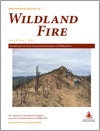International Journal of Wildland Fire
Volume 29
Number 7 2020
Surveys of hikers at a burned site in California showed high familiarity with prescribed fire and general fire ecology, but not local fire history. Hikers had complex feelings about the role of wildfire, but generally enjoy hiking in a burned landscape, finding the experience surprising and interesting.
Two different scenarios for assigning liability for damage to timber value incurred when wildland fire crosses property boundaries are modelled. Outcomes are compared with one scenario in which there is no liability for damage and one scenario in which there is a single landowner.
Fire weather and behaviour models can inform tactical and strategic decision-making on fire events, but models take time to generate reliable output and managers may not trust them. Technical specialists play an active role in overcoming these barriers. Models inform but do not dictate decisions.
Although most maps of fire regimes are derived from fire data, we spatially delineated eight distinctive fire regime ecoregions in California based on an unsupervised classification of biophysical and anthropogenic variables. The map corresponded well with the major land cover types of the state and provided clear separation of historical fire frequency and size.
We reconstructed historical fire activity from tree rings in riparian plots and combined them with existing fire histories from adjacent upland plots in the Blue Mountains of eastern Oregon, USA. From 1650 to 1900, fires burned at a similar frequency between riparian and adjacent upland plots. During more than half of the fire years, fires were spatially extensive and burned synchronously in riparian and upland plots, and climate was significantly dry during these years.
Riparian vegetation and geomorphic properties of mountain stream reaches that burned with high- or low-severity fire did not differ from each other in this California, USA study. However, the proportion of each catchment burned multiple times over the past ~80 years was correlated with reach-level geomorphic metrics.
Seeds of hard-seeded species require heat to break their seed coat dormancy and enable germination to occur. We tested simulated post-fire temperatures (50–70°C) on the germination of dormant seeds of nine Fabaceae species. More germination of small-seeded species (<12.6 mg) occurred than large-seeded species (>14.0 mg). Soil heating <70°C did not affect seeds of large-seeded species but small-seeded species were more likely to have dormancy broken, suggesting their residual soil seed bank will be reduced after fire, threatening their persistence in the landscape.
Wildfires seem to amplify the differences for quantity and quality of soil organic matter and microbial amount and activity in soils under herbaceous and tree covers. This study investigated soil properties and microbial communities after fires that occurred in the summer of 2017 in Vesuvius National Park. Soils covered by herbaceous species, compared with those covered by trees, seem to be more sensitive to the overall variations owing to fire, and less able to restore their functionality – probably a result of the lowest microbial abundance and higher carbon losses.
We experimentally determined the combustibility of organic soils from representative Tasmanian vegetation communities. We found soil combustion was primarily determined by moisture content, with a slight influence of organic content. Analysis of meteorological data shows most Tasmanian organic soils are probably combustible for at least a few days each summer.





